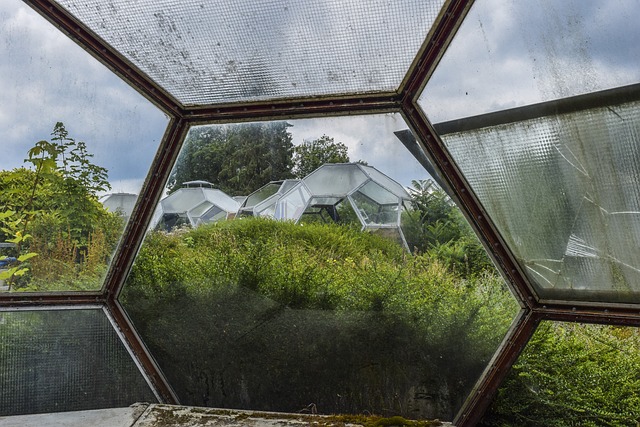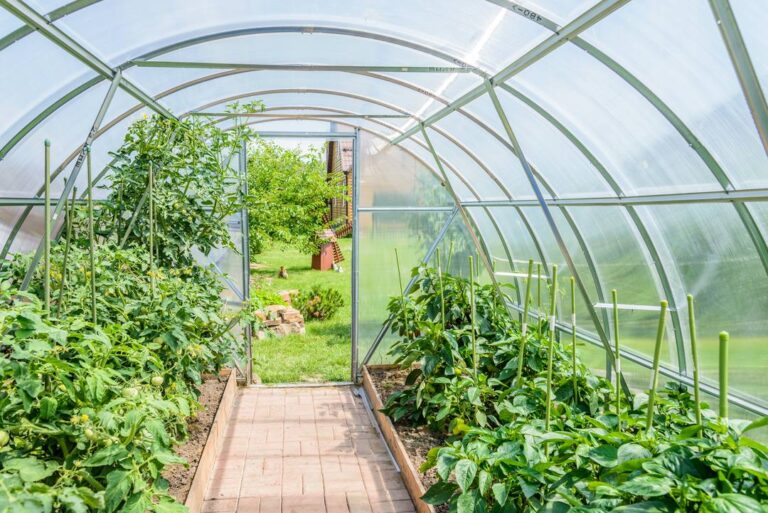One sunny morning in my garden, I wondered how to make my plants happy. I had a tough choice: should I get a polytunnel or a greenhouse? It was like having a big question mark in my head, just like the morning mist on my tomato plants.
In this article, I’ll take you on my adventure to learn about polytunnels and greenhouses.
Polytunnels and greenhouses are structures for gardening, but they differ in construction, cost, and functionality. Polytunnels are affordable, made of lightweight materials, and offer basic climate control. Polytunnels are more flexible in size and customization.
On the other hand, greenhouses are pricier, made with durable materials, and provide precise climate control. Greenhouses transmit more light, last longer, and are visually appealing. Your choice depends on budget, plant needs, and climate conditions.
What Are The Features of a Poly Tunnel?

A poly tunnel, also known as a polyethylene tunnel, is a type of greenhouse structure.
It typically consists of a series of hoops or arches made from metal or PVC, covered with a single or double layer of polyethylene plastic.
Poly tunnels are designed to create a controlled environment for gardening by capturing sunlight and trapping heat.
Advantages of Using a Poly Tunnel
Cost-effectiveness :
- Poly tunnels are generally more cost-effective compared to traditional greenhouses.
- The materials used, such as polyethylene plastic and simple metal or PVC frames, are affordable.
- This cost-effectiveness makes them accessible to a wider range of gardeners and farmers.
Flexibility :
- Poly tunnels are highly flexible in terms of size and shape.
- They can be easily extended or modified to accommodate changing gardening needs.
- This adaptability is particularly valuable for gardeners with limited space or evolving cultivation requirements.
Climate Control
Poly tunnels offer reasonable climate control capabilities.They provide a warmer and more stable environment for plants compared to open-field cultivation.
Furthermore, polyethylene plastic sheets help retain heat, making it possible to extend the growing season and protect plants from adverse weather conditions.
Limitations of Poly Tunnels
Durability
Poly tunnels may not be as durable as traditional greenhouses. The plastic covering is susceptible to wear and tear over time, especially in areas with harsh weather conditions or strong UV radiation.
Regular maintenance, such as replacing plastic sheets, is necessary to ensure longevity.
Limited Insulation
While polytunnels offer some climate control, their insulation properties are not as efficient as those of greenhouses with double-layered glass or polycarbonate panels. Additionally, extreme temperature fluctuations can still occur inside poly tunnels.
Moreover, gardeners may need to supplement insulation with additional measures, like adding thermal screens or using heating systems in colder climates.
What Are The Features of a Greenhouse?
A greenhouse is a controlled environment designed for the cultivation of plants.
It is typically a building or structure with transparent walls and a roof, made of materials like glass, polycarbonate, or acrylic.
Moreover, greenhouses are designed to capture and retain solar energy, creating a warm and controlled microclimate for plants.
Advantages of Using a Greenhouse
Superior Insulation : Greenhouses provide superior insulation compared to poly tunnels or open-field cultivation.The transparent materials used for walls and roof allow sunlight to enter while trapping heat, creating a stable and warm environment.
In addition, this insulation helps protect plants from temperature extremes and adverse weather conditions.
Enhanced Temperature Control : Greenhouses offer precise temperature control through ventilation, shading, and heating systems.Gardeners can manipulate the internal temperature and humidity levels to create optimal conditions for different plant varieties.
Furthermore, this control is especially valuable for starting seedlings and growing heat-sensitive crops.
Year-round Gardening :
Greenhouses enable year-round gardening in various climates.By maintaining a consistent and favorable environment, greenhouses extend the growing season beyond traditional outdoor limits.
Moreover, this allows for continuous harvests and the cultivation of plants that would otherwise not survive harsh winters.
Limitations of Greenhouses
Higher Initial Cost: Greenhouses typically require a higher initial investment compared to poly tunnels.The cost is associated with materials like glass or polycarbonate panels, as well as ventilation and climate control systems.
However, this investment can yield long-term benefits and increased productivity.
Less Flexibility: Greenhouses are less flexible in terms of size and modification compared to poly tunnels.Expanding or altering a greenhouse structure can be more complex and costly. Furthermore, this may limit adaptability for gardeners with changing needs or limited space.
What Are The Key Differences between PolyTunnels and Greenhouses?
Polytunnels and greenhouses are different in how they’re built. Polytunnels have bendy, hoop-shaped frames covered in plastic, while greenhouses have solid, flat frames with glass or plastic walls.
Structure and Materials
Poly Tunnels: Typically constructed with metal or PVC arches covered with polyethylene plastic. Lightweight and easy to assemble. The materials are cost-effective but may require more frequent replacement.
Greenhouses: Feature more robust structures made of materials like glass, polycarbonate, or acrylic. These materials offer superior insulation and durability but come at a higher initial cost.
Climate Control Capabilities
Poly Tunnels: Offer basic climate control by retaining heat through plastic covering. Temperature fluctuations can still occur, especially in extreme weather.
Greenhouses: Provide precise temperature and humidity control through ventilation, shading, and heating systems. This capability makes them suitable for growing a wider range of plants and extending the growing season.
Durability and Maintenance
Poly Tunnels: Generally have a shorter lifespan compared to greenhouses due to the wear and tear of plastic covering. Regular maintenance, such as replacing plastic sheets, is essential.
Greenhouses: Are more durable and require less frequent maintenance. Glass or polycarbonate panels are resistant to UV radiation and weather, resulting in a longer lifespan.
Cost Considerations
Poly Tunnels: Initial costs are lower, making them more budget-friendly. However, ongoing maintenance and replacement costs should be factored in.
Greenhouses: Involve a higher initial investment but often offer better long-term value due to durability and advanced climate control capabilities. The cost may be justified for serious gardeners or commercial growers.
What Factors Should You Consider Between a Poly Tunnel and a Greenhouse?

When deciding between a polytunnel and a greenhouse, consider factors like your budget, the climate in your area, the type of plants you want to grow, and the level of maintenance you’re willing to undertake. These factors will help you choose the best option for your gardening needs.
Climate and Location
Consider your local climate, including temperature extremes, precipitation, and sunlight. Greenhouses are better suited for areas with harsh winters, while poly tunnels may suffice in milder climates.
Budget
Evaluate your budget for the initial investment as well as ongoing maintenance costs. Determine how much you’re willing to invest in your gardening shelter.
Gardening Goals and Plants
Identify the types of plants you intend to grow. Greenhouses are more versatile for various plant species, including tropical and exotic varieties. Poly tunnels are suitable for less sensitive crops.
Long-Term Plans
Consider your long-term gardening goals. If you plan to expand or have a consistent need for climate-controlled space, a greenhouse may be a better investment. If flexibility and lower initial costs are your priorities, a poly tunnel might be the right choice.
FAQ’s
Are polytunnels good for the environment?
Polytunnels can be environmentally friendly when used for sustainable agriculture. They can extend growing seasons, reducing the need for transportation of out-of-season produce.
What is a poly tunnel used for?
A polytunnel is primarily used for gardening and agriculture. It provides a protected environment for plants, extending the growing season and protecting them from pests and harsh weather.
Why is it called a polytunnel?
It’s called a polytunnel because it is constructed using a lightweight frame covered with polyethylene plastic. “Poly” refers to the plastic material used for the covering.
Are polytunnels cheaper than greenhouses?
Yes, polytunnels are generally more affordable than greenhouses due to their less expensive materials and simpler construction.
What material is used for polytunnel?
Polytunnels are typically made with a lightweight frame (e.g., steel or PVC) covered with polyethylene plastic for the walls and roof.
Do polytunnels get too hot?
Polytunnels can become hot during sunny days, but their temperature control is less precise compared to greenhouses. Proper ventilation and shading can help regulate the temperature inside a polytunnel.
Conclusion
In summary, after exploring the nuances of PolyTunnels and Greenhouses, I find myself with a deeper appreciation for the intricate choices gardeners face when selecting a shelter for their plants. Each option has its distinct advantages and limitations that cater to varying needs.
Poly Tunnels, with their cost-effectiveness and flexibility, appeal to those working with tighter budgets and evolving gardening requirements.
On the other hand, Greenhouses stand out with their superior insulation and precise climate control, making them a compelling choice for year-round and diverse plant cultivation. The choice between the two ultimately hinges on a multitude of factors, including climate, budget, plant selection, and long-term aspirations.

